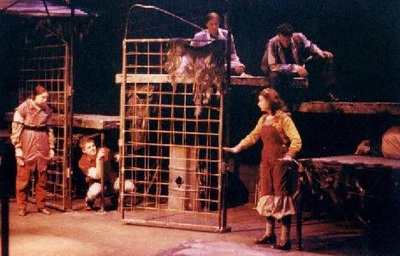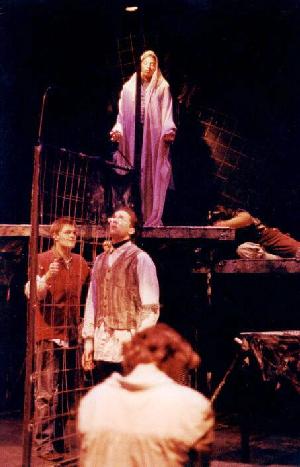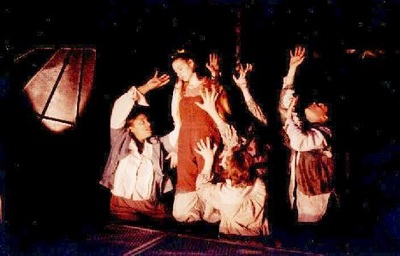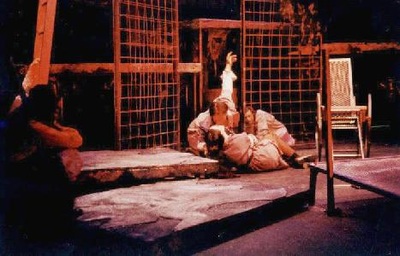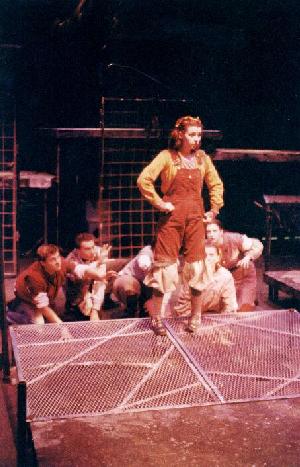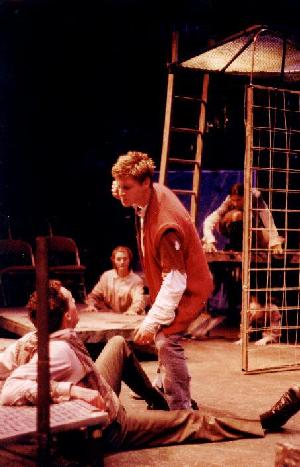Lion in the Streets
Humboldt State University, 1997
These photos are the property of Patrick Spike, please do not duplicate, download, copy or print without expressed permission. Thank you.
Concept Statement, Lion in the Streets
Introduction
I first encountered this script in a contemporary drama class at Western Washington University. A fellow student brought it in as a suggested addition to our list of plays for the quarter. I was immediately drawn to this script with its raw characters, nightmarish world, impressionistic qualities, and exploration of a side of ourselves as human beings that I had never considered before. Judith Thompson has a way of finding an equity to her characters where the lines of good and bad are never clear, and they all share mutual dilemmas where no one is innocent or guilty. I knew I wanted to direct this play.
When I was considering what production to direct next as part of my MFA degree it came to mind. I wanted a project that would truly stretch my work into new arenas. I had a great deal of experience coming into my MFA program. With that experience I had developed a personal approach to my work that worked well and that could be easily modified and adjusted to suit the project, theatre, cast and crew. What I was looking for in this particular choice, however, was a challenge to work in an entirely new way. I wanted to explore truly organic realms and hopefully try to develop an approach that was still organized and productive. I have encountered so many directors who supposedly work ‘organically’ and in actuality are simply using the term to hide the fact that they really don’t know what they want or how to get it. I was instead looking for an exploration into a truly organic process where every member of the company was equally creative in the process and the lines of who created what were unnecessary.
Concept & Goals (as distributed at the first production meeting)
The play explores:
We as human beings never really trust each other. We can never feel that others aren’t hiding things from us, giving us half-truths, secretly plotting behind our backs, deceiving us, lying to us. We always question truth. We all know that we, ourselves, lie to others. With any given statement we often hide our true feelings. The subtext is implied. Our truth is disguised and withheld. We know we do it, so we know it to be true of others. This lack of trust, this inability to not suspect deception, leads to an engulfing estrangement from each other. With this estrangement comes fear. Since we can never truly know the real thoughts of those around us, we fear them. We fear what they think of us. We suspect and question their motives. The framework within which we attempt to live will not hold. Our place in the world and those "givens" which we attempt to hold onto disintegrate. Our desperate need to belong is unsatisfied. It is this open-ended fear that exposes the dark side of our society, of humanity. The fear leads to hatred, to violence, to a constant relentless uneasiness from which we cannot escape.
Specific Elements:
This play examines humanity as an ultimately primitive, animalistic society despite our technological and industrial achievements.
The characters in this play are layered. While they display carelessness and violence, their actions are precipitated by fear. We will investigate the roots of their fears and how it has taken hold in their psyches. These layers are reflected in the multiple casting of actors and should also be reflected in their unit costumes.
"Thompson’s theatre challenges the notion of a unitary fixed self, showing individual identities under attack, changing, and being constructed." - Kathy Chung, "Emotions and Facts" Canadian Literature
This play functions outside the boundaries of naturalism. It swiftly shifts in time and space. We must avoid limiting our thinking to a realistic world. The situations within which the characters find themselves grow from often seemingly normal events into the stuff of our nightmares. They become the outward and forward expression of these characters' deepest fears and insecurities.
"…her characters seem to lose the common division between a private and public self. After setting up a seemingly familiar social context, Thompson’s characters erupt and express themselves in masterful expressionist and surreal theatrical moments." - Kathy Chung, "Emotions and Facts" Canadian Literature
Actors not currently participating in a given ‘scene’ will physicalize the ‘lion’ prowling, watching, hunting, manipulating, etc. Occasionally, the actors within a scene will become the ‘lion’ for a moment, relating the ‘animal within.’ Actors will seldom, if ever, leave stage.
Elements In Summary:
1) Estrangement -- fear -- hatred/violence/constant relentless uneasiness
2) Primitive/animalistic vs./with technology/industry
3) Layering
4) Normal events to nightmares
5) Actors as the lion
Design Considerations:
Set: Space allowing for freedom of movement of the actors portraying the ‘lion’ as they move about the scene in progress. Also a simplicity of scene definition to allow for a fluid movement of the action. How can the primitive include the industrial? The emotional mix with the mechanical?
Costume/Makeup: Unit costume allowing a freedom of movement for the actors as they physicalize the ‘lion’ and allowing for the physicality of some of the characters. Again, how can the many characters be layered? Exposed and hidden? Clear yet indiscernible?
Lights: Provide assistance in the definition of time and place while also providing texture, tone, atmosphere and enhancing the above concepts.
Sound: Reinforce and help to create the ‘lion’ providing its ‘roar.’ Explore the primitive together with the technological/industrial. Again, avoid getting stuck in realism in the choices of sound. How can we suggest a lion within layers? Other sound possibilities to be discussed.
On Judith Thompson:
Judith Thompson hears the poetry of the inarticulate and the semi-literate, embodying the colloquialisms, the brand names, the fractured but expressive syntax, with the urgency of their speakers. She frees her words to carry their wild, unruly, seeking spirits. These characters do terrible things, and they have terrible things done to them. They have no champions, except for their playwright, who in creating them gives them, unequivocally, their moment of self-knowledge, their moment of dignity, their moment of visionary ecstasy.
The other threat to sustaining life is the animalistic side within each of us - the darker, unconscious, libidinous, sometimes destructive, chaotic dream-world inside, ‘the other side of the dark.’ The fluidity of Judith Thompson’s language, with its free, unexpected rhythms, has made it possible for her always to suggest the swift, vibrating oscillation between conscious and unconscious states.
…rich and dense with the exploration of ‘the animal behind the wall,’ or the beast within. … Harsh attempts to eliminate the animal leave a gaping searing vacuum. … The solution to the throbbing, buzzing honeycomb behind the Mack’s wall is to ‘carve these holes in it.’
The candid, almost giddy non-privacy of her characters is probably one of the things that most excites some audiences about Judith Thompson’s work, and also what repels and disturbs some others.
‘Nothing human disgusts me.’ Everything is human. Our dreams, our words, our actions, our orgasms, our shit – everything defines us. Judith Thompson doesn’t judge her characters. The animal – the other side of the dark - they are within us, part of us. … Her plays contain shocking betrayals and exceptional loyalties, but they are part of the same impulse. … In the shadows of such paradoxes, Judith Thompson’s characters struggle with their sins, their self-hatred, their guilt. They grapple with their animal.
Bleak, harrowing and frightening as they may be, the movement of Judith Thompson’s plays is usually regenerative - from sin toward grace, from the tornado of suffocation to the restoration of breath.
Taken from an introduction to The Other Side of the Dark, a collection of 4 Thompson Plays. Written by Urjo Kareda, August 1989, Artistic Director of Toronto’s Tarragon Theatre where Lion… and other Thompson plays have originated.
Concept Unifying Metaphor
Imagine an old, decaying tenement building now undergoing demolition. As the wrecking ball swings and rips away a layer of wall, not only is fractured wood, plaster, steel exposed, but so are dwellings. We see into the lives of individuals, members of this enclosed community, hive. Entire histories are exposed in the glimpses of faded wallpaper, snapshots, worn furniture, someone’s past. The ball swings in again and rips it down, exposing more layers, a crack lab next door, graffiti on the walls of the hall. Swing, rip, hidden screams of a battered wife. Swing, rip, crumble, someone’s grandfather, rarely visited. With each layer is the history of lives having been lived, childhood memories, the parasites of humanity next door to loved-ones. Layer upon layer rising to the surface, being uncovered.
Challenges and Approach
First of all, this play and this concept required an incredible ensemble within the cast. We had to develop a sense of the Lion’s ‘pack’ within the group, where they could seamlessly and instinctively move, react, interact, balance and support each other, without ever having to contemplate. To this end I spent nearly two weeks in movement workshops with the cast. Hours of group movement and exploration felt like mere minutes. The beauty and power of the group surfaced over the course of these explorations and I was truly amazed. By having specific plans for each session, while also improvising based on inspiration from the group itself, the actors trusted me implicitly and put their whole selves into the work. It was remarkable how the sense of ensemble developed. They grew to predict each others movements to the point where group exercises needed no leader or followers. It was magical.
Next we began work on the scenes themselves. I wanted to specifically avoid ‘blocking’ the show myself and rather have this movement come about naturally. We instead spent a week simply working through the scenes, discussing them in depth between us, including all their abstract ideas and possibilities. The cast by this time felt so secure with each other that they freely shared their ideas and exciting discoveries were made frequently. This exploration then continued on the beginnings of our wild jungle-gym like set.
Finally, it came time to set the movement down on the set, permanently. In preparation I decided to write framework blocking down in my script, based on what had come out of our working sessions. I planned to then talk to the cast and set it down quickly. What happened however, was remarkable. As we began running scenes with the rest of the cast now ‘prowling’ behind as they eventually would be, the scenes took amazing shape on their own. The intense feeling of ensemble brought about amazing stage pictures, incredible balance and tension. The collaboration was perfect. The designers took even further inspiration from the actors' remarkable work. The show fell into place. At that point we were then left to polish scenes, experiment with levels, timing, interactions, and moments. This was a truly amazing experience for us all.
Outcome
As stated above, this production and its process were incredible. I consider this one of my most successful projects. I discovered an entirely new way of working. Although I know it is not right for every project or every group of individuals, it is another way for me to approach my work. This project was highly regarded by all at HSU. It was even deemed a perfect example of what HSU’s theatre department strives for in process and production by a faculty member and former department chair. Audience members left the theatre thinking about what they had just experienced and many were still thinking about it weeks after asking me questions about the abstract and impressionistic material. I hope to engage in more work like this in the future.
Introduction
I first encountered this script in a contemporary drama class at Western Washington University. A fellow student brought it in as a suggested addition to our list of plays for the quarter. I was immediately drawn to this script with its raw characters, nightmarish world, impressionistic qualities, and exploration of a side of ourselves as human beings that I had never considered before. Judith Thompson has a way of finding an equity to her characters where the lines of good and bad are never clear, and they all share mutual dilemmas where no one is innocent or guilty. I knew I wanted to direct this play.
When I was considering what production to direct next as part of my MFA degree it came to mind. I wanted a project that would truly stretch my work into new arenas. I had a great deal of experience coming into my MFA program. With that experience I had developed a personal approach to my work that worked well and that could be easily modified and adjusted to suit the project, theatre, cast and crew. What I was looking for in this particular choice, however, was a challenge to work in an entirely new way. I wanted to explore truly organic realms and hopefully try to develop an approach that was still organized and productive. I have encountered so many directors who supposedly work ‘organically’ and in actuality are simply using the term to hide the fact that they really don’t know what they want or how to get it. I was instead looking for an exploration into a truly organic process where every member of the company was equally creative in the process and the lines of who created what were unnecessary.
Concept & Goals (as distributed at the first production meeting)
The play explores:
We as human beings never really trust each other. We can never feel that others aren’t hiding things from us, giving us half-truths, secretly plotting behind our backs, deceiving us, lying to us. We always question truth. We all know that we, ourselves, lie to others. With any given statement we often hide our true feelings. The subtext is implied. Our truth is disguised and withheld. We know we do it, so we know it to be true of others. This lack of trust, this inability to not suspect deception, leads to an engulfing estrangement from each other. With this estrangement comes fear. Since we can never truly know the real thoughts of those around us, we fear them. We fear what they think of us. We suspect and question their motives. The framework within which we attempt to live will not hold. Our place in the world and those "givens" which we attempt to hold onto disintegrate. Our desperate need to belong is unsatisfied. It is this open-ended fear that exposes the dark side of our society, of humanity. The fear leads to hatred, to violence, to a constant relentless uneasiness from which we cannot escape.
Specific Elements:
This play examines humanity as an ultimately primitive, animalistic society despite our technological and industrial achievements.
The characters in this play are layered. While they display carelessness and violence, their actions are precipitated by fear. We will investigate the roots of their fears and how it has taken hold in their psyches. These layers are reflected in the multiple casting of actors and should also be reflected in their unit costumes.
"Thompson’s theatre challenges the notion of a unitary fixed self, showing individual identities under attack, changing, and being constructed." - Kathy Chung, "Emotions and Facts" Canadian Literature
This play functions outside the boundaries of naturalism. It swiftly shifts in time and space. We must avoid limiting our thinking to a realistic world. The situations within which the characters find themselves grow from often seemingly normal events into the stuff of our nightmares. They become the outward and forward expression of these characters' deepest fears and insecurities.
"…her characters seem to lose the common division between a private and public self. After setting up a seemingly familiar social context, Thompson’s characters erupt and express themselves in masterful expressionist and surreal theatrical moments." - Kathy Chung, "Emotions and Facts" Canadian Literature
Actors not currently participating in a given ‘scene’ will physicalize the ‘lion’ prowling, watching, hunting, manipulating, etc. Occasionally, the actors within a scene will become the ‘lion’ for a moment, relating the ‘animal within.’ Actors will seldom, if ever, leave stage.
Elements In Summary:
1) Estrangement -- fear -- hatred/violence/constant relentless uneasiness
2) Primitive/animalistic vs./with technology/industry
3) Layering
4) Normal events to nightmares
5) Actors as the lion
Design Considerations:
Set: Space allowing for freedom of movement of the actors portraying the ‘lion’ as they move about the scene in progress. Also a simplicity of scene definition to allow for a fluid movement of the action. How can the primitive include the industrial? The emotional mix with the mechanical?
Costume/Makeup: Unit costume allowing a freedom of movement for the actors as they physicalize the ‘lion’ and allowing for the physicality of some of the characters. Again, how can the many characters be layered? Exposed and hidden? Clear yet indiscernible?
Lights: Provide assistance in the definition of time and place while also providing texture, tone, atmosphere and enhancing the above concepts.
Sound: Reinforce and help to create the ‘lion’ providing its ‘roar.’ Explore the primitive together with the technological/industrial. Again, avoid getting stuck in realism in the choices of sound. How can we suggest a lion within layers? Other sound possibilities to be discussed.
On Judith Thompson:
Judith Thompson hears the poetry of the inarticulate and the semi-literate, embodying the colloquialisms, the brand names, the fractured but expressive syntax, with the urgency of their speakers. She frees her words to carry their wild, unruly, seeking spirits. These characters do terrible things, and they have terrible things done to them. They have no champions, except for their playwright, who in creating them gives them, unequivocally, their moment of self-knowledge, their moment of dignity, their moment of visionary ecstasy.
The other threat to sustaining life is the animalistic side within each of us - the darker, unconscious, libidinous, sometimes destructive, chaotic dream-world inside, ‘the other side of the dark.’ The fluidity of Judith Thompson’s language, with its free, unexpected rhythms, has made it possible for her always to suggest the swift, vibrating oscillation between conscious and unconscious states.
…rich and dense with the exploration of ‘the animal behind the wall,’ or the beast within. … Harsh attempts to eliminate the animal leave a gaping searing vacuum. … The solution to the throbbing, buzzing honeycomb behind the Mack’s wall is to ‘carve these holes in it.’
The candid, almost giddy non-privacy of her characters is probably one of the things that most excites some audiences about Judith Thompson’s work, and also what repels and disturbs some others.
‘Nothing human disgusts me.’ Everything is human. Our dreams, our words, our actions, our orgasms, our shit – everything defines us. Judith Thompson doesn’t judge her characters. The animal – the other side of the dark - they are within us, part of us. … Her plays contain shocking betrayals and exceptional loyalties, but they are part of the same impulse. … In the shadows of such paradoxes, Judith Thompson’s characters struggle with their sins, their self-hatred, their guilt. They grapple with their animal.
Bleak, harrowing and frightening as they may be, the movement of Judith Thompson’s plays is usually regenerative - from sin toward grace, from the tornado of suffocation to the restoration of breath.
Taken from an introduction to The Other Side of the Dark, a collection of 4 Thompson Plays. Written by Urjo Kareda, August 1989, Artistic Director of Toronto’s Tarragon Theatre where Lion… and other Thompson plays have originated.
Concept Unifying Metaphor
Imagine an old, decaying tenement building now undergoing demolition. As the wrecking ball swings and rips away a layer of wall, not only is fractured wood, plaster, steel exposed, but so are dwellings. We see into the lives of individuals, members of this enclosed community, hive. Entire histories are exposed in the glimpses of faded wallpaper, snapshots, worn furniture, someone’s past. The ball swings in again and rips it down, exposing more layers, a crack lab next door, graffiti on the walls of the hall. Swing, rip, hidden screams of a battered wife. Swing, rip, crumble, someone’s grandfather, rarely visited. With each layer is the history of lives having been lived, childhood memories, the parasites of humanity next door to loved-ones. Layer upon layer rising to the surface, being uncovered.
Challenges and Approach
First of all, this play and this concept required an incredible ensemble within the cast. We had to develop a sense of the Lion’s ‘pack’ within the group, where they could seamlessly and instinctively move, react, interact, balance and support each other, without ever having to contemplate. To this end I spent nearly two weeks in movement workshops with the cast. Hours of group movement and exploration felt like mere minutes. The beauty and power of the group surfaced over the course of these explorations and I was truly amazed. By having specific plans for each session, while also improvising based on inspiration from the group itself, the actors trusted me implicitly and put their whole selves into the work. It was remarkable how the sense of ensemble developed. They grew to predict each others movements to the point where group exercises needed no leader or followers. It was magical.
Next we began work on the scenes themselves. I wanted to specifically avoid ‘blocking’ the show myself and rather have this movement come about naturally. We instead spent a week simply working through the scenes, discussing them in depth between us, including all their abstract ideas and possibilities. The cast by this time felt so secure with each other that they freely shared their ideas and exciting discoveries were made frequently. This exploration then continued on the beginnings of our wild jungle-gym like set.
Finally, it came time to set the movement down on the set, permanently. In preparation I decided to write framework blocking down in my script, based on what had come out of our working sessions. I planned to then talk to the cast and set it down quickly. What happened however, was remarkable. As we began running scenes with the rest of the cast now ‘prowling’ behind as they eventually would be, the scenes took amazing shape on their own. The intense feeling of ensemble brought about amazing stage pictures, incredible balance and tension. The collaboration was perfect. The designers took even further inspiration from the actors' remarkable work. The show fell into place. At that point we were then left to polish scenes, experiment with levels, timing, interactions, and moments. This was a truly amazing experience for us all.
Outcome
As stated above, this production and its process were incredible. I consider this one of my most successful projects. I discovered an entirely new way of working. Although I know it is not right for every project or every group of individuals, it is another way for me to approach my work. This project was highly regarded by all at HSU. It was even deemed a perfect example of what HSU’s theatre department strives for in process and production by a faculty member and former department chair. Audience members left the theatre thinking about what they had just experienced and many were still thinking about it weeks after asking me questions about the abstract and impressionistic material. I hope to engage in more work like this in the future.


